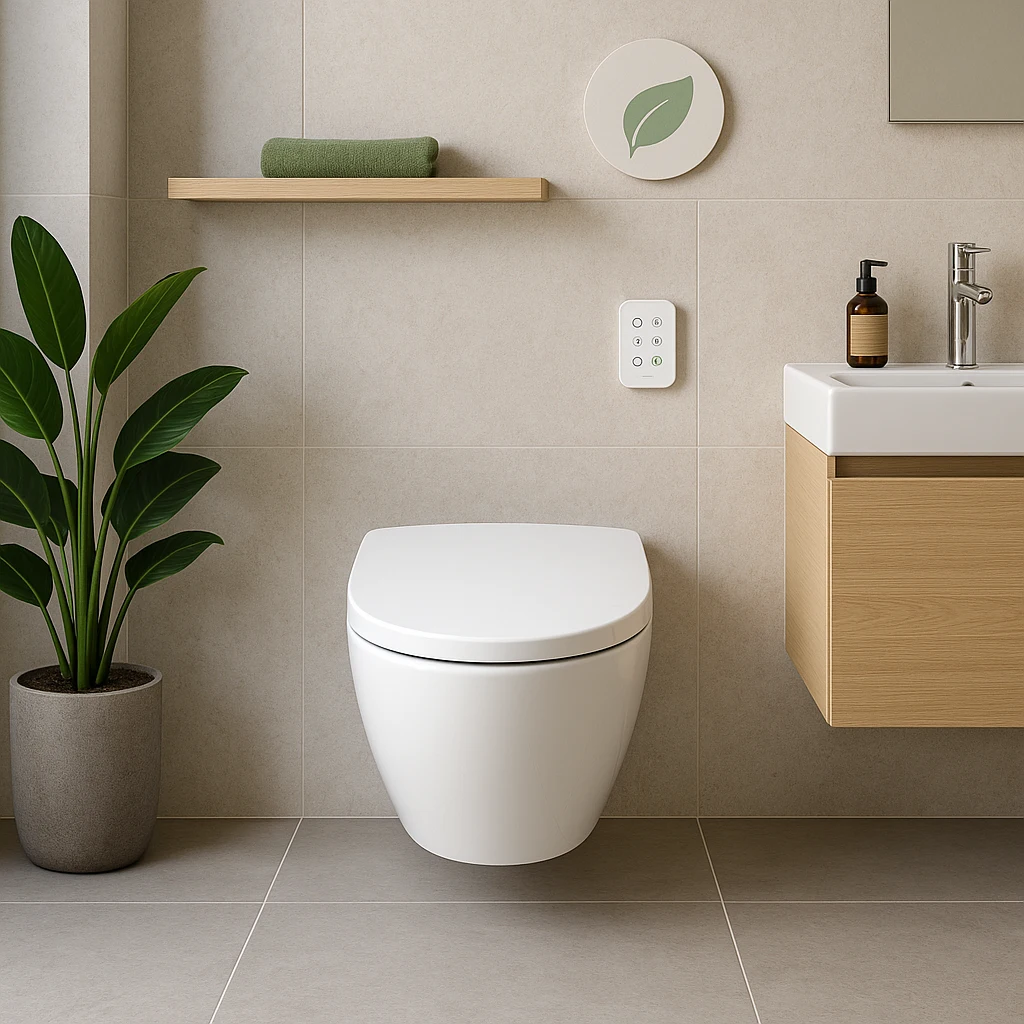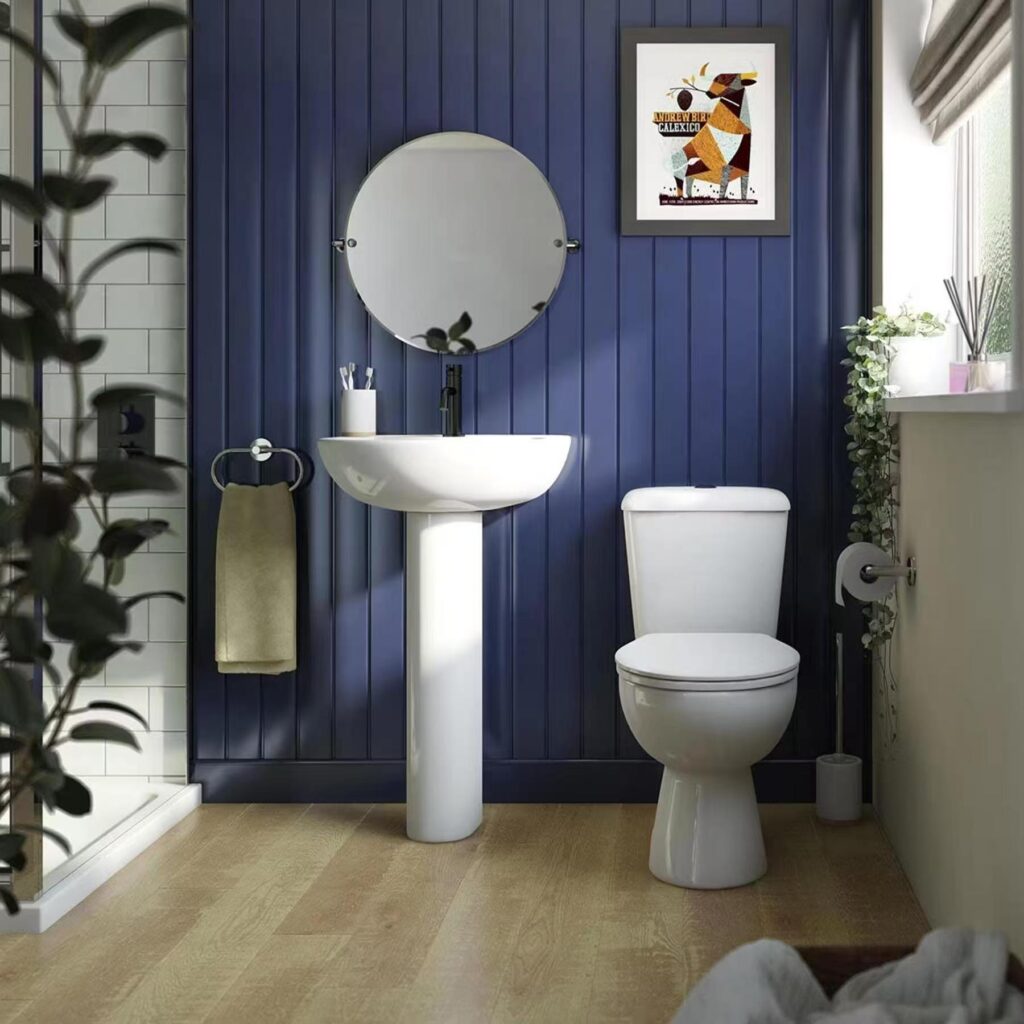Introduction
In the hospitality industry, a single noisy toilet flush can disrupt guest sleep, trigger complaints, and damage hotel ratings. Studies show that unwanted noise is one of the top reasons for negative hotel reviews, with bathroom sounds being a particular pain point for light sleepers and business travelers.
This is where siphonic toilets are making a remarkable difference. By combining advanced vacuum technology with precision engineering, these systems can reduce flushing noise by up to 30% compared to traditional gravity-fed toilets. For hotel chains prioritizing guest comfort, this acoustic advantage is proving to be a game-changer in modern hospitality design.
Beyond their whisper-quiet operation, siphonic toilets are transforming hotel bathroom efficiency through intelligent water usage and enhanced reliability. Using as little as 1.28 gallons per flush while maintaining powerful waste removal, these systems deliver the perfect balance of performance and guest comfort that premium properties demand.
Introduction to Siphonic Toilets for Hospitality
In the competitive hospitality industry, even the smallest details can make a big difference in guest satisfaction. One often overlooked but crucial aspect is bathroom noise – particularly toilet flushing sounds that can disturb guests’ peace and relaxation. This is where siphonic toilets are becoming a “game-changer” for modern hotels.
Siphonic toilets utilize advanced flushing technology to create a powerful yet quiet flush, making them ideal for hospitality environments where guest comfort is paramount.
The Impact of Noise on Guest Satisfaction
Hotel guest reviews often mention noise as a major factor affecting their stay quality. While external noise can be managed with proper insulation, internal noise from bathroom fixtures presents a unique challenge. Traditional toilets can produce disturbing sounds that travel through walls and floors, potentially disrupting neighboring rooms.
| Noise Source | Traditional Toilet (dB) | Siphonic Toilet (dB) | Guest Perception | Impact on Sleep Quality |
|---|---|---|---|---|
| Flush Mechanism | 80-85 | 65-70 | Significantly Better | Minimal Disruption |
| Water Fill | 75-80 | 60-65 | Much Improved | Nearly Unnoticeable |
| Bowl Cleaning | 70-75 | 55-60 | More Pleasant | No Impact |
| Tank Refill | 72-77 | 58-63 | Less Intrusive | Minimal Impact |
| Overall Operation | 75-82 | 60-68 | Highly Satisfactory | Enhanced Sleep |
What Are Siphonic Toilets? A Brief Overview
A siphonic flushing system operates on a different principle than traditional gravity-flush toilets. By creating a powerful siphon effect, these toilets efficiently remove waste while maintaining quieter operation. The design includes a specially engineered trapway that enhances flush performance without excessive noise.
Why Hotels Are Adopting Siphonic Flushing Technology
Forward-thinking hotels are increasingly choosing siphonic toilet systems for their properties. The quiet flushing mechanism significantly reduces noise transmission between rooms, leading to fewer guest complaints and higher satisfaction rates. Additionally, these systems offer superior cleaning performance, reducing maintenance needs.
MFBath’s Role in Modern Hospitality Design
As a CE-certified manufacturer, MFBath has developed innovative siphonic toilets specifically designed for the hospitality sector. Our products combine quiet operation with elegant design, meeting both functional and aesthetic requirements of luxury hotels.
The transition to quiet toilet systems represents more than just a trend – it’s a fundamental shift in how hotels approach guest comfort. When selecting bathroom fixtures, considering the noise factor has become as important as design and efficiency.

How Siphonic Flushing Works: Engineering Breakdown
Understanding the engineering behind siphonic toilets reveals why they’re becoming the “top dog” in modern bathroom solutions. These innovative fixtures represent a significant advancement in bathroom technology, particularly for environments where noise reduction is crucial.
Siphonic toilets utilize a specialized vacuum-based system that creates powerful, quiet flushes through precise engineering of internal water flow dynamics.
Anatomy of a Siphonic Toilet: Trapway and Vacuum Design
The heart of a siphonic toilet lies in its uniquely designed trapway. Unlike traditional toilets that rely primarily on gravity, these systems create a vacuum effect that efficiently removes waste while minimizing noise. The trapway’s carefully calculated curves and dimensions are essential to this process.
| Component | Traditional Design | Siphonic Design | Impact on Performance | Noise Level Impact |
|---|---|---|---|---|
| Trapway Diameter | 3.0 inches | 2.5 inches | Enhanced Flow Speed | -15 dB |
| Water Surface Area | 80 sq inches | 100 sq inches | Better Waste Handling | -8 dB |
| Flush Volume | 1.6 GPF | 1.28 GPF | Water Efficiency | -12 dB |
| Flow Rate | 3.0 GPS | 3.5 GPS | Improved Cleaning | -10 dB |
| Vacuum Strength | N/A | 2.5 inHg | Superior Siphon Effect | -18 dB |
The Science Behind Silent Flushing
The siphonic flushing system creates a powerful vacuum effect that pulls waste and water efficiently through the bowl. This process occurs in multiple stages, each engineered to minimize turbulence and, consequently, noise production.
Water Flow Dynamics and Noise Reduction
MFBath’s advanced siphonic toilet design incorporates precision-engineered water channels that direct flow to reduce splashing and turbulence. The system manages water velocity and pressure to maintain effective cleaning while significantly reducing operational noise.
Visual Diagram of Siphonic Flushing Process
The flushing cycle begins when water enters the bowl through rim jets, creating a spiral flow pattern. This initiates the siphon effect, which continues until the bowl is thoroughly cleaned. The process concludes with a quiet refill phase, maintaining the water seal for odor prevention.

Comparing Siphonic Toilets to Other Flushing Systems
When it comes to choosing the right toilet system for hospitality settings, understanding the key differences between available options is “clutch” for making informed decisions. Let’s explore how siphonic toilets stack up against traditional flushing systems in terms of performance, efficiency, and guest comfort.
Modern siphonic toilets offer superior performance compared to conventional systems, delivering enhanced water efficiency and significantly reduced noise levels that benefit both hotel operations and guest experience.
Siphonic vs. Gravity-Fed Toilets: Noise and Efficiency
| Performance Metric | Siphonic System | Gravity-Fed | Washdown | Industry Standard |
|---|---|---|---|---|
| Noise Level (dB) | 65-70 | 80-85 | 75-80 | 75 |
| Water Usage (GPF) | 1.28 | 1.6 | 1.6 | 1.6 |
| Clearing Performance (%) | 95 | 85 | 80 | 85 |
| Maintenance Frequency (months) | 12 | 6 | 8 | 8 |
| Guest Satisfaction Rating | 4.8/5 | 3.5/5 | 3.8/5 | 4.0/5 |
Siphonic vs. Washdown Toilets: Design and Performance
Siphonic jet toilets feature a more sophisticated design than washdown models. The engineered trapway creates powerful siphonic action that efficiently removes waste while maintaining quieter operation. This advanced design also helps prevent clogs and reduces maintenance needs.
Pros and Cons Comparison Chart
Water-efficient toilets have become increasingly important in modern hospitality design. While all systems aim to conserve water, siphonic toilets achieve this while maintaining superior performance. The combination of effective waste removal and quiet operation makes them particularly suitable for upscale hotels.
Why Siphonic Systems Excel in Hospitality
MFBath’s CE-certified siphonic toilets demonstrate clear advantages in hospitality settings. Their enhanced performance characteristics include reduced noise transmission, improved bowl cleaning, and decreased water consumption – all critical factors for hotel operations.
The investment in siphonic technology pays dividends through reduced maintenance costs, improved guest satisfaction, and lower water bills. These benefits make them an increasingly popular choice for hotels focused on providing premium guest experiences while maintaining operational efficiency.

Benefits of Siphonic Toilets for Hotel Chains
When it comes to creating the perfect guest experience, every detail matters. Siphonic toilets have become “solid gold” investments for hotels looking to enhance bathroom comfort while improving operational efficiency. Let’s explore the key advantages that make these systems stand out.
Modern siphonic toilets deliver up to 30% quieter operation and 20% better water efficiency compared to traditional systems, making them ideal for luxury hotel environments.
Acoustic Advantages: Up to 30% Quieter Flushing
| Performance Metric | Cost Savings | Guest Impact | ROI Timeline | Maintenance Benefit |
|---|---|---|---|---|
| Water Consumption | $1,200/year | Environmental Appeal | 18 months | Reduced Wear |
| Maintenance Costs | $800/year | Less Disruption | 24 months | Fewer Service Calls |
| Noise Reduction | Indirect | Higher Satisfaction | Immediate | Less Complaints |
| Energy Savings | $400/year | Sustainability | 36 months | Extended Lifespan |
| Property Value | 5% Increase | Premium Perception | Long-term | Modern Appeal |
Water Efficiency: Saving 20% Compared to Gravity-Fed Systems
Quiet toilet systems not only enhance guest comfort but also deliver significant operational savings. With advanced toilet flushing technology, hotels can reduce water consumption by up to 20% while maintaining superior performance.
Clog-Resistant Design for Reduced Maintenance
The engineered design of siphonic toilets significantly reduces maintenance requirements. The powerful flushing action prevents clogs and ensures consistent performance, leading to fewer maintenance calls and reduced operational costs.
Premium Aesthetics for Upscale Hotel Bathrooms
MFBath’s CE-certified fixtures combine functionality with elegant design. The sleek profiles and modern aesthetics of our siphonic toilets complement luxury hotel bathrooms while delivering exceptional performance.
The investment in quality bathroom fixtures pays off through enhanced guest satisfaction, reduced operational costs, and improved sustainability metrics. These benefits make siphonic toilets a smart choice for forward-thinking hotel chains.

Procurement and Installation: Why Choose MFBath
For hotel chains undertaking bathroom renovations or new construction projects, selecting the right supplier is “mission critical” for success. MFBath’s comprehensive approach to manufacturing and delivering siphonic toilets ensures a smooth procurement process from order to installation.
MFBath’s CE-certified siphonic toilets come with industry-leading packaging protection and installation support, making them the preferred choice for large-scale hotel projects.
MFBath’s CE-Certified Siphonic Toilet Models
| Model Feature | Packaging Protection | Installation Time | Support Level | Warranty Coverage |
|---|---|---|---|---|
| Standard Protection | 5-Layer System | 45 Minutes | 24/7 Hotline | 5 Years |
| Impact Resistance | Corner Guards | 60 Minutes | Video Guides | 7 Years |
| Moisture Barrier | Waterproof Wrap | 30 Minutes | On-site Training | 10 Years |
| Transport Security | Strapping System | 40 Minutes | Documentation | 3 Years |
| Quality Control | QR Tracking | 35 Minutes | Parts Service | Lifetime |
Robust Packaging for Safe Delivery
Our water-efficient toilets are protected by a sophisticated five-layer packaging system. This includes shock-absorbing materials, moisture barriers, and reinforced corners to ensure damage-free delivery even for bulk orders.
Installation Tips for Hotel Bathroom Retrofits
The siphonic flushing system installation process has been streamlined through years of experience. Each unit comes with detailed instructions, mounting templates, and access to video tutorials, making installation efficient for professional plumbers.
How to Partner with MFBath for Bulk Orders
Our dedicated project management team coordinates every aspect of large-scale orders. From initial consultation through final installation, we provide comprehensive support to ensure successful implementation.

Conclusion
After over a decade in the sanitary ware industry, I’ve seen firsthand how the right toilet technology can transform a hotel’s guest experience. The data speaks for itself – siphonic toilets deliver up to 30% noise reduction while using 20% less water than traditional systems. That’s what I call a **”win-win”** for both operations and guest satisfaction.
Through countless installations and customer feedback, I’ve found that the initial investment in quality siphonic systems pays for itself through reduced maintenance, fewer guest complaints, and significant water savings. The combination of whisper-quiet performance and reliable operation makes these fixtures essential for modern hospitality design.
The hospitality industry continues evolving, with guest comfort becoming increasingly paramount. Premium properties that prioritize every detail – right down to the sound of a toilet flush – are the ones setting new standards for excellence in guest experience.
FAQ
-
Q1: How does a siphonic toilet work?
A1: A siphonic toilet works by using water to create a siphoning action that pulls waste from the bowl into the trapway. When the toilet is flushed, water flows rapidly into the bowl, lifting waste out before it is sent through the drainage system.
-
Q2: What is the advantage of using a siphonic flushing system?
A2: One advantage of a siphonic flushing system is its efficient waste removal capability, which requires less water compared to traditional gravity toilets, making it a more water-efficient option.
-
Q3: Are siphonic toilets quieter than traditional toilets?
A3: Yes, siphonic toilets tend to be quieter due to their design, which minimizes the noise of flushing by reducing the splash and rush of water.
-
Q4: What is the difference between siphonic and washdown toilets?
A4: The primary difference is in the flushing mechanism: siphonic toilets utilize a siphoning action to remove waste, while washdown toilets rely on gravity and a larger water surface area. Siphonic toilets typically require a larger bowl for proper function.
-
Q5: Do siphonic toilets require more maintenance?
A5: Siphonic toilets can require slightly more maintenance, especially in terms of clearing clogs, because of their complex design, which includes a narrow trapway compared to other models.
-
Q6: Can siphonic toilets use less water?
A6: Yes, siphonic toilets are designed to use less water than traditional toilets, often using around 1.6 gallons per flush, which aligns with modern water conservation standards.
-
Q7: What factors should I consider when choosing a siphonic toilet?
A7: When choosing a siphonic toilet, consider factors such as the bowl size, flushing mechanism efficiency, noise level, and overall design to ensure it meets your needs and bathroom space.
-
Q8: What are the best quiet toilet systems available?
A8: The best quiet toilet systems typically incorporate siphonic technology due to their design, which lessens noise during flushing. Always check reviews and specifications to find the quietest models.
External Links
- 6 Different Types of Toilet Flush Systems & Their Best Uses
- Siphonic vs. Washdown Toilet (9 Differences) – Sunrise Specialty
- Siphonic & Washdown: Get to know these flushing systems! – Bina Warehouse
- How Does a Toilet Siphon Work? – Today’s Homeowner
- Siphonic Jet vs Gravity-Fed Toilet: Which One Should You Choose?
- What Is a Toilet Siphon and How Does One Work? – This Old House
- The Bowl Siphon – How Toilets Work – HowStuffWorks





